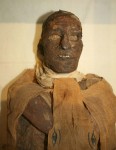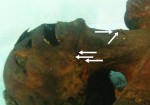 Egyptologists have long known that 20th Dynasty pharaoh Ramesses III was the target of a palace coup at the end of his life. The Judicial Papyrus of Turin, a 3000-year-old trial record that was translated into English and published as early as 1865, documents the aftermath of the Harem Conspiracy in which Queen Tiye, one of Pharoah Ramesses III’s wives, enlisted the aid of various members of the pharaoh’s household to assassinate him while he spent the evening in the royal harem.
Egyptologists have long known that 20th Dynasty pharaoh Ramesses III was the target of a palace coup at the end of his life. The Judicial Papyrus of Turin, a 3000-year-old trial record that was translated into English and published as early as 1865, documents the aftermath of the Harem Conspiracy in which Queen Tiye, one of Pharoah Ramesses III’s wives, enlisted the aid of various members of the pharaoh’s household to assassinate him while he spent the evening in the royal harem.
Tiye wanted her son Pentawere to succeed his father as pharaoh, while Ramesses had designated his eldest surviving son Amonhirkhopshef, the future Ramesses IV, as his heir. She conspired with her son, other women in the harem, the pharaoh’s chief of chamber, treasury officials, butlers, court magicians, army commanders, royal scribes and a passel of harem inspectors to kill Ramesses and incite a rebellion that would oust Amonhirkhopshef and put Pentawere on the throne. In April 1155 B.C., 31 years and one month into Ramesses’ reign, the coup was discovered and the conspirators tried for their great crimes.
It’s not clear from the historical record if the plot was foiled before assassination was attempted, or if it was attempted and failed or what injuries Ramesses III might have suffered as a result. The Judicial Papyrus describes him as convening the court that presided over the trials of the conspirators, but it also refers to him as “Great God,” a naming convention only applied to deceased pharaohs at that time. One theory posits that he was poisoned (court magicians were particularly good at that sort of thing) but survived just long enough to appoint the 12 judges before succumbing. Another suggests that Ramesses III was indeed felled in the Harem Conspiracy and the trial was convened by his son Ramesses IV, but since the son didn’t want to start his reign with an investigation into such the sordid, bloody, black magical murder of his father, he retconned the trial as having been ordered by Ramesses III.
The mummy of Ramesses III, discovered in 1886 in Valley of the Kings tomb KV11, doesn’t show any obvious wounds. Previous forensic examination found no cause of death or telltale signs of assassination. To finally answer the question of whether Ramsesses III was killed in the Harem Conspiracy, a team of Egyptologists and biologists led by Dr. Albert Zink from the Institute for Mummies and the Iceman of the European Academy of Bolzano/Bozen in Italy (known for his work on Otzi the Iceman) CT scanned the mummy and discovered a proverbial smoking gun hidden under the thick collar of linen wrappings: Ramesses III’s throat was cut and cut deep.
The CT investigation revealed a serious wound in the throat of Ramesses III’s mummy, directly under the larynx. The injury was roughly 70 mm wide and extended to the bones (fifth to seventh cervical vertebra), severing all soft tissue areas in the anterior side of the neck. The trachea was clearly cut and its proximal and distal ends were retracted and separated by about 30 mm. A small, focal cortical interruption at the anterior surface of vertebral body was visible, at the seventh cervical vertebra. Accordingly, all organs in this region (such as the trachea, oesophagus, and large blood vessels) were severed.
It’s highly unlikely that he survived this attack, and if he did live for a minute, he probably wasn’t appointing judges. Researchers also found a Horus eye emblem inserted into the wound by embalmers to promote healing.
The team also examined a second mummy found in the same tomb known officially as Unknown Man E and informally as the Screaming Man because of his open-mouthed expression. Screaming Man is a fascinating archaeological anomaly. Although found in a royal tomb, E was buried in an unmarked coffin devoid of all proper ritual markings and with his hands and feet bound. He was also covered with a goatskin, a “ritually impure” element that would prevent him from reaching the afterlife.
 Why so deliberately offensive a burial in the tomb of kings? Could E be Pentawere, doomed by his parricidal scheme? The answer is probably. Genetic testing has confirmed that E and Ramesses III were directly related to each other in the paternal line. Forensic examination found wrinkles under the mandible and on the neck that indicate strangulation. If it is Pentawere, that’s new information since the Judicial Papyrus records him killing himself.
Why so deliberately offensive a burial in the tomb of kings? Could E be Pentawere, doomed by his parricidal scheme? The answer is probably. Genetic testing has confirmed that E and Ramesses III were directly related to each other in the paternal line. Forensic examination found wrinkles under the mandible and on the neck that indicate strangulation. If it is Pentawere, that’s new information since the Judicial Papyrus records him killing himself.